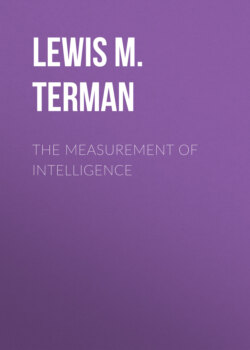Читать книгу The Measurement of Intelligence - Lewis M. Terman - Страница 39
На сайте Литреса книга снята с продажи.
Sources of data.
ОглавлениеTable of Contents
Our revision is the result of several years of work, and involved the examination of approximately 2300 subjects, including 1700 normal children, 200 defective and superior children, and more than 400 adults.
Tests of 400 of the 1700 normal children had been made by Childs and Terman in 1910–11, and of 300 children by Trost, Waddle, and Terman in 1911–12. For various reasons, however, the results of these tests did not furnish satisfactory data for a thoroughgoing revision of the scale. Accordingly a new investigation was undertaken, somewhat more extensive than the others, and more carefully planned. Its main features may be described as follows:—
1. The first step was to assemble as nearly as possible all the results which had been secured for each test of the scale by all the workers of all countries. The result was a large sheet of tabulated data for each individual test, including percentages passing the test at various ages, conditions under which the results were secured, method of procedure, etc. After a comparative study of these data, and in the light of results we had ourselves secured, a provisional arrangement of the tests was prepared for try-out.
2. In addition to the tests of the original Binet scale, 40 additional tests were included for try-out. This, it was expected, would make possible the elimination of some of the least satisfactory tests, and at the same time permit the addition of enough new ones to give at least six tests, instead of five, for each age group.
3. A plan was then devised for securing subjects who should be as nearly as possible representative of the several ages. The method was to select a school in a community of average social status, a school attended by all or practically all the children in the district where it was located. In order to get clear pictures of age differences the tests were confined to children who were within two months of a birthday. To avoid accidental selection, all the children within two months of a birthday were tested, in whatever grade enrolled. Tests of foreign-born children, however, were eliminated in the treatment of results. There remained tests of approximately 1000 children, of whom 905 were between 5 and 14 years of age.
4. The children’s responses were, for the most part, recorded verbatim. This made it possible to re-score the records according to any desired standard, and thus to fit a test more perfectly to the age level assigned it.
5. Much attention was given to securing uniformity of procedure. A half-year was devoted to training the examiners and another half-year to the supervision of the testing. In the further interests of uniformity all the records were scored by one person (the writer).
